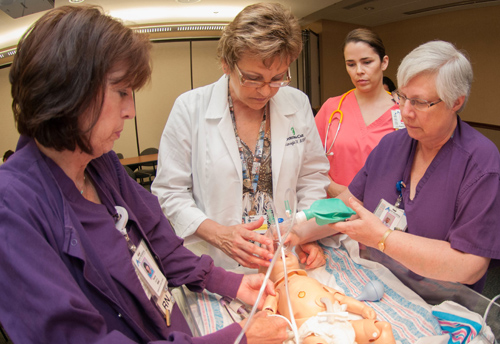Simulator training helps nurses statewide learn neonatal intensive care techniques


Christiana Care’s expert Neonatal ICU transport team has a road show featuring Newborn Hal, a high-tech infant simulator mannequin that offers hands-on practice in neonatal intensive care techniques.
HAL has been used at Christiana Care for more than a year, said Cynthia Kelley, NNP. It is one of a wide variety of robotic mannequins and simulators used for pediatric and adult medical education.
“The nice thing about Hal,’’ she said, “is that he’s portable.”
A team of four nurse practitioners and Wendy Sturtz, M.D., medical director of Neonatal Outreach Education, has taken Newborn Hal to trainings at Nanticoke Memorial Hospital in Seaford, Del., Union Hospital in Elkton, Md., and Jennersville Regional Hospital in West Grove, Pa., to help those hospitals increase proficiency in caring for high-risk babies. These and other local hospitals served by Christiana Care’s Neonatal Transport Team benefit from the advanced training when sick infants need to be transported to Christiana Care’s Level 3 NICU. Christiana Care is the only delivering hospital in Delaware to have this highest level of capability for a NICU.
Before a sick infant is ready to be transported, the baby should be stabilized according to a trademarked protocol, The STABLE Program. STABLE is shorthand for sugar, temperature, airway, blood pressure, lab work and emotional support
“The STABLE program is the gold standard in neonatal education,” Kelley said. It has been used at Christiana Care since 2003 to provide education and training in common problems in neonatal care. Now Hal simulation offers a new way of providing training that will improve care of babies before they arrive at Christiana Care.
Simulation training has proven to be effective not only in medical applications, but also by astronauts, city planners, military strategists and others, said Rachel Baldwin, MSN, NNP-BC. “It’s what a lot of people are using for low-volume but high-risk procedures,” Baldwin said. “If we can practice with our simulators, nurses can be much more comfortable when practicing that skill in the field. It helps them to get familiar with the equipment they’re using.’’
Newborn Hal can stage training to achieve a range of skill sets, Kelley said. It produces sound that duplicates normal or defective heartbeats and breathing, color changes and other vital signs. Medical staff “have to listen, make decisions based on what they’re seeing and their assessment, and decide what to do next. It can be a short scenario or a long, involved scenario,” she said.
The opportunity to practice infrequently needed procedures builds confidence in the nursing staff and promotes teamwork, said Union Hospital nurse educator Chavon Crampton, MSN, RNC-MNN, CCD, CLC. High-risk deliveries don’t happen frequently at Union Hospital, “but they happen often enough that we need to know what to do,’’ Crampton said. “If you don’t do it every day, it’s definitely important to practice, because anything can happen.”
During simulation training, the baby’s heart rate or breathing can suddenly change with all the unpredictability of real life, Crampton said. This requires the trainees to think critically and work together.
“The idea is to make everyone think, to do the interventions and be more confident and comfortable, so when the real deal comes along, they know what they’re doing,’’ she said. “If they make a mistake, the patient is not hurt. It’s nice to be able to work through a situation, take time to talk it through and think how can we do it better.’’